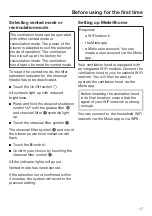
IMPORTANT SAFETY INSTRUCTIONS
9
– 4) You can fight the fire with your back to an exit.
*Based on “Kitchen Fire Safety Tips” published by NFPA.
The ventilation hood may become damaged if exposed to
excessive heat from a gas cooktop.
- When using the ventilation hood over a gas cooktop, ensure that
any burners in use are always covered by cookware. Turn burners
off when removing the cookware, even if doing so for just a short
time.
- Select cookware that is suitable for the size of the burner.
- Adjust the flame so that it never extends up the sides of the
cookware.
- Avoid overheating the cookware (e.g., when cooking with a wok).
Always turn the ventilation hood on whenever a burner is in use to
prevent damage from condensation.
Overheated oil and fat can ignite, causing fire damage to the
ventilation hood.
Do not leave cookware, pans, and deep-fat fryers unattended when
cooking with oil or fat. Similarly, never leave an open flame
unattended when grilling.
Fat and debris deposits impair the proper functioning of the
ventilation hood.
To ensure that cooking vapors are properly cleaned, never use the
ventilation hood without the grease filters in place.
Please note that the heat rising from the stovetop during cooking
can cause the ventilation hood to become very hot.
Do not touch the housing or the grease filters until the ventilation
hood has cooled down.
Содержание DAS 4930
Страница 14: ...Guide to the ventilation hood 14 ...
Страница 44: ...M Nr 12 039 190 00 en US DAS 4930 ...










































